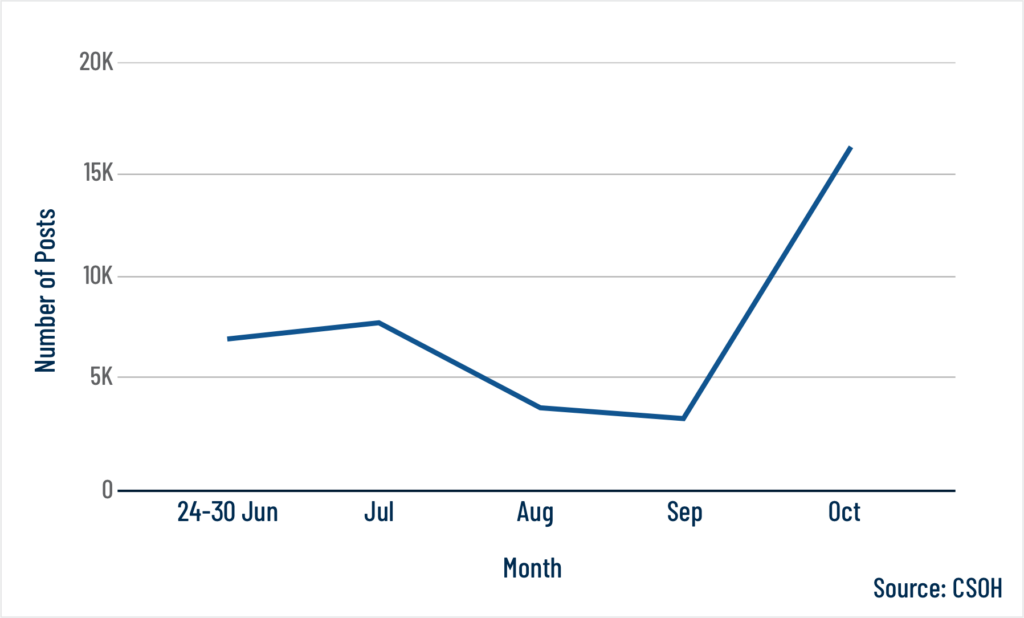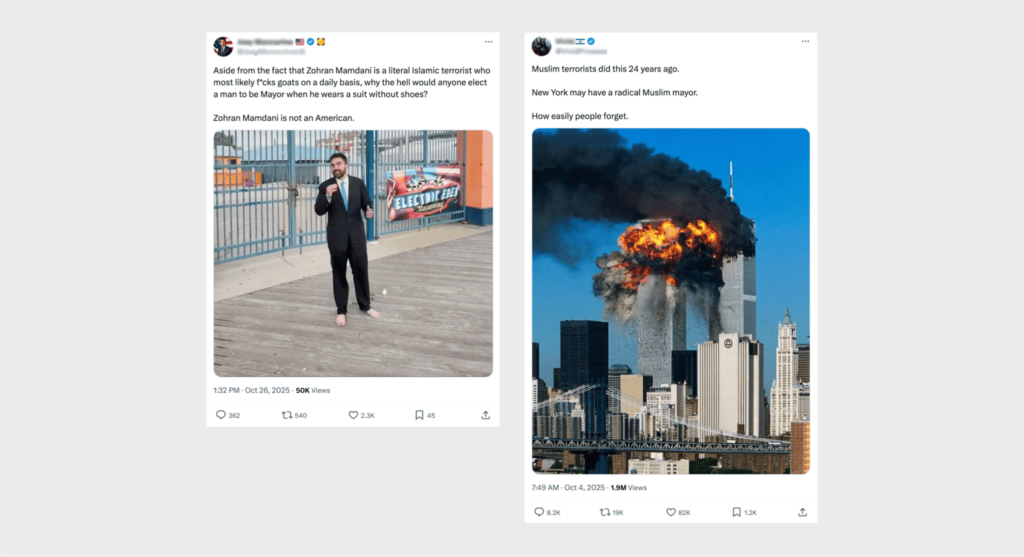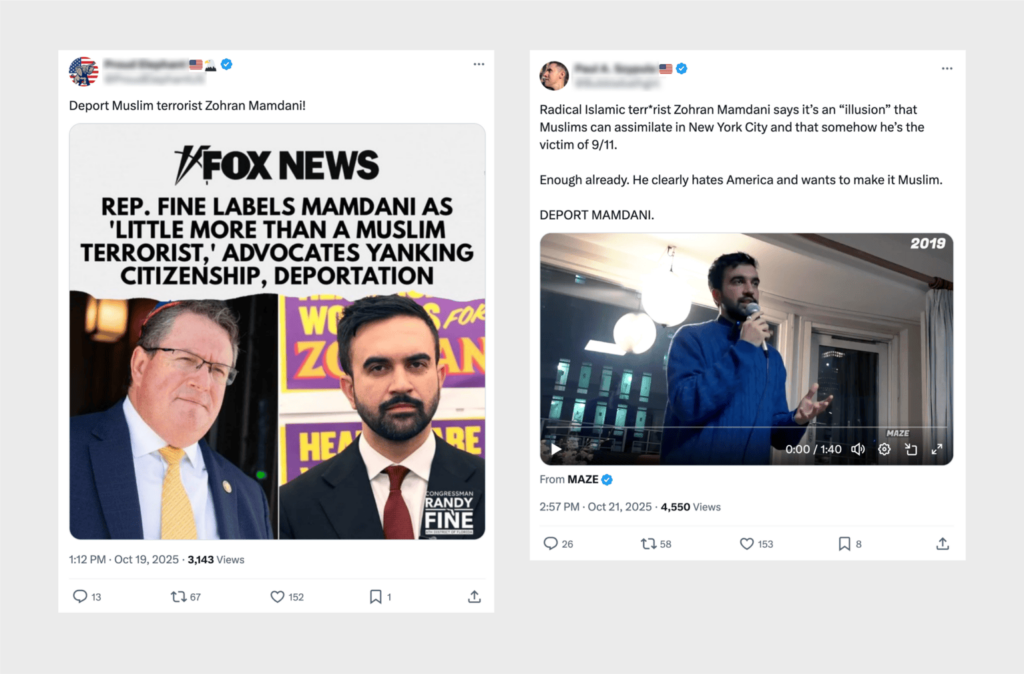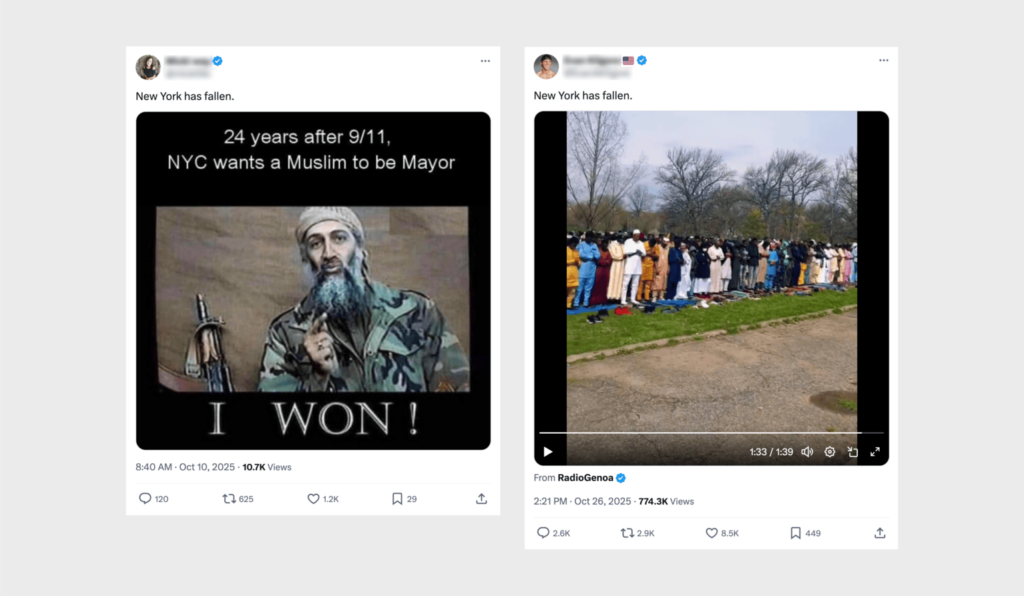Introduction
Throughout the New York City mayoral general election, Zohran Mamdani has received widespread national and international attention as both the first Muslim and Democratic Socialist candidate. As a result of his religious identity and political views, politicians and media pundits consistently push fearmongering discourse that portrays Mamdani as an existential threat. A significant part of this discourse has circulated on the social media platform X (formerly Twitter).
This report provides an update of our previous analysis of the New York City mayoral primary, since Mamdani won the Democratic party nomination on June 24, 2025, up to October 31. New data collected from this time period aligns with our previous findings of the key themes dominating social media discourse. Namely, an overarching emphasis on Islamophobia, constructing Mamdani as a terrorist, jihadist, or radical Muslim, as well as positioning Muslim Americans as an overall target out-group; equating Mamdani’s Muslim faith and Islam as inherently incompatible with American political and civic values through the use of dog whistles and conspiratorial narratives; questioning Mamdani’s status as a naturalized U.S. citizen with calls for his denaturalization and deportation; and fomenting nativist sentiment that portrays Mamdani as unpatriotic and an enemy to the nation.
Our analysis of the mayoral primary election found that much of the discourse focused on Mamdani’s political ideology–labeled as a communist infiltration–which often intersected with Islamophobic narratives to demonize Mamdani as a suspected “infiltrator” cast as both Muslim and socialist. These narratives persisted throughout the general election, however, we focus on the overt Islamophobia that permeated and substantially increased from June 24 to October 31. Anti-Muslim sentiment became a salient issue throughout the general election, which culminated into a press conference on October 24 with Mamdani addressing rampant Islamophobia directed towards him and Muslim New Yorkers. This raises profound implications concerning the ability of Muslim Americans to fully participate in civic and political life, in which open hostility and suspicion undermine democratic values of equality and dignity.
Key Findings
- Between June 24 and October 31, we identified 35,522 original Islamophobic and Xenophobic posts authored by 17,752 unique accounts on X.
- Original posts collectively received 7.37 million likes and 2.01 million reposts, generating an estimated reach of 1.5 billion.
- Nearly four in ten accounts (39 percent) spreading Islamophobic or Xenophobic content were verified blue-badge users, generating almost 45 percent of all original posts.
- Islamophobic narratives intensified over time, with October alone accounting for 43 percent of total posts, an increase of more than 450 percent compared with September.
- Extremist and terrorist labeling dominated the dataset, representing approximately 72 percent of all original posts and framing Mamdani as a terrorist or radical threat.
- Islamization conspiracies accounted for 2,868 posts (8 percent), advancing claims of “sharia law,” “Muslim takeover,” and other fear-based narratives.
- Calls for Mamdani’s deportation and revoking citizenship comprised 4,055 posts (11 percent).
- Patriotism and loyalty attacks included 3,085 posts (9 percent) from 2,293 authors, employing terms such as “traitor,” “enemy within,” and “anti-American.”
Methodology
To trace how these harmful narratives targeting Mamdani circulated on X during the mayoral election campaign, we applied a mixed-methods approach combining quantitative and qualitative techniques. Using a social listening tool and keyword search terms, we assembled a corpus of posts for quantitative measurement supplemented by qualitative content analysis.
We built upon a broad conceptual frame of anti-Muslim sentiment and Islamophobia developed in our previous report to identify and update a set of keywords for searching public posts published between June 24 and October 31 on X. The following Boolean search was used to confine content review to content most relevant to Mamdani, the election, and harmful speech:
(“Zohran Mamdani” | ZohranMamdani | Zohran | Mamdani | Mumdani | Mamdami | @ZohranKMamdani) + (“terrorist” | “terror” | “terrorism” | “terror sympathizer” | “terrorist sympathizer” | “jihadi” | “jihad” | “jihadist” | “islamist” | “muslim terrorist” | “radical” | “radical muslim” | “radical islamist” | “muslim extremist” | “extremist” | “sharia” | “sharia law” | “Taqiyya” | “muslim takeover” | “islam takeover” | “send back” | “kick out” | “traitor” | “enemy within” | “enemy” | “deport” | “deporting” | “remigrate” | “re-migrate” | “remigration” | “denaturalize” | “denaturalization” | “unamerican” | “anti american” | “anti america” | “against america” | “muslim takeover” | “islamic takeover” | “revoke citizenship” | “islamic theocracy” | “new york has fallen”)
Using a social listening tool, this keyword search yielded 35,522 original posts generated by 17,752 unique authors. We then segmented the data into four categories for qualitative content analysis: 1) Extremist and terrorist labeling; 2) Islamization conspiracy theories; 3) Calls for deportation and denaturalization; and 4) Patriotism and loyalty attacks, which are analyzed below.
Our analysis was limited to public posts gathered over approximately four months (June 24 to October 31, 2025). We did not collect or analyze posts shared earlier (with the exception of our previous report on the mayoral primary election, which employed a different methodology), posts deleted before collection, or posts originating from private accounts. Additionally, our data collection and analysis focus on original posts and their engagement metrics, excluding the engagement metrics of reposts and replies. Engagement metrics reflect counts as of October 31, 2025 at 4:00 PM Eastern Time (ET). Author counts by category are not additive, as several users appear across multiple themes. The overall dataset includes 17,752 distinct authors after deduplication. Lastly, qualitative coding into categories for analysis involved human reviewers, but no formal reliability test. Despite these limitations, we were able to capture relevant insights on the scale and scope of Islamophobic and xenophobic narratives targeting Mamdani that persisted on X during the New York City mayoral campaign.
Data Analysis
Between June 24, the day of the New York City mayoral primary, and October 31, CSOH documented an unprecedented wave of Islamophobic discourse directed at Zohran Mamdani and the mayoral race on X. The analysis identified a total of 35,522 original posts authored by 17,752 unique accounts containing Islamophobic, xenophobic, or exclusionary language.
Figure 1. Volume of X Posts from June 24 to October 31

The total number of posts in our dataset generated 7.37 million likes and 2.01 million reposts, with an estimated reach of 1.5 billion, underscoring the scale and virality of Islamophobic and xenophobic discourse surrounding the campaign. Of the total number of authors, 6,868 accounts (39 percent) were verified blue-badge users who produced 16,039 posts, accounting for approximately 45 percent of all Islamophobic content recorded during the observation period.
Figure 2. Key Metrics of Overall Engagement and Reach

The content of these posts coalesced around four recurring narrative themes: 1) Labeling Mamdani as a terrorist or extremist, 2) Promoting conspiracies of Islamization, 3) Calling for Mamdani’s deportation or denaturalization, and 4) Attacking his patriotism and loyalty to the U.S. Together, these themes reflect a digital ecosystem where Islamophobia serves as both a political weapon and a cultural marker of exclusion. The extremist and terrorist labeling theme accounted for an overwhelming majority of the dataset, illustrating how accusations of terrorism and extremism remain central to Islamophobic discourse. The other three themes, while smaller in proportion, reveal the layered strategies through which online harmful narratives escalate.
Over the five-month observation period, Islamophobic content displayed a clear upward trajectory. Between June 24 and 30, 7,163 original posts were recorded, representing approximately 20 percent of all identified content. July maintained a similar level, with 7,520 posts (21 percent).
Figure 3. Monthly Distribution of Islamophobic and Xenophobic Posts (June 24 – October 31, 2025)

Activity then declined sharply in August and September, amounting to 2,972 (8 percent) and 2,744 (8 percent) posts, respectively. In October, the volume of Islamophobic discourse rose dramatically to 15,123 posts, accounting for 43 percent of the total dataset. This figure represents an increase of more than 450 percent compared with September, signaling a significant and sustained escalation. The late-stage surge suggests a renewed and potentially coordinated amplification of Islamophobic narratives as the mayoral campaign entered its final phase.
Extremist and Terrorist Labeling
The largest and most dominant theme in the dataset was extremist and terrorist labeling of Mamdani. Between June 24 and October 31, this category accounted for 25,514 original posts, representing approximately 72 percent of all Islamophobic content, generated by 12,844 unique authors.
Figure 4. Key Metrics of Engagement for the Extremist and Terrorist Labeling

The language in this cluster consistently portrayed Mamdani as a violent threat, using terms such as “terrorist”, “terror sympathizer”, “jihadi”, “Islamist”, “radical Muslim”, and “extremist”. These posts frequently framed his Muslim identity as inherently linked to terrorism, echoing two decades of post-9/11 tropes that associate Muslim political participation with national security concerns.

Significantly, this narrative moved beyond criticism of an individual candidate and instead reflected a broader tendency to conflate Muslim identity with extremism. By repeatedly framing Mamdani in the context of terrorism, these posts questioned his legitimacy as a political actor and, by extension, cast suspicion on Muslim participation in democratic life. The “terrorist” framing further provided the conceptual basis for other strands of Islamophobic discourse observed in the dataset, particularly those related to patriotism, loyalty, and national belonging.
Islamization Conspiracies
The second theme involved Islamization conspiracy theories, encompassing 2,868 original posts (or around 8 percent of the total), authored by 2,132 users. This cluster revolved around the claim that electing a Muslim politician would lead to the imposition of “sharia law” or the establishment of an “Islamic theocracy” in New York City.
Figure 5. Key Metrics of Engagement for the Islamization Conspiracies

These posts commonly used phrases such as “Muslim takeover”, “Islamic takeover”, and “taqiyya”, the latter being a theological term distorted by far-right actors to allege that Muslims practice deception to conceal extremist intent.

The Islamization conspiracy narrative functioned as a fear-based political weapon. It suggested that Mamdani’s candidacy symbolized the loss of American or Western cultural dominance, echoing far-right movements in Europe and the UK, which describe Muslim populations as a demographic invasion through conspiracies such as Eurabia and the Great Replacement.
Posts within this category often included edited images and memes portraying New York City as falling under “Islamic rule”, a visual manifestation of the “civilizational threat” trope that circulates widely within transnational Islamophobia networks.
Calls for Deportation and Denaturalization
The third major theme captured explicit exclusionary rhetoric calling for Mamdani’s removal from the country or revocation of his citizenship. This category included 4,055 posts accounting for roughly 11 percent of the dataset, generated by 3,233 unique authors. The posts included phrases like “send back”, “kick out”, “deport”, “denaturalize”, and “remigrate”.
Figure 6. Key Metrics of Engagement for the Deportation and Denaturalization

The posts in this theme demonstrate the convergence of Islamophobia with nativist and exclusionary narratives. Assertions that a Muslim elected official should be expelled or stripped of citizenship framed political participation as conditional and limited to certain religious or ethnic groups.

The overlap with the “terrorist” narrative was particularly notable, as many posts depicted Mamdani as a security threat before advancing demands for his deportation, indicating a progression from stigmatization to explicit exclusion.
The phrase “remigration”, once an obscure concept among European far-right activists and ideologues, likewise gained traction during the mayoral general election period. Used as a shorthand to call for the forced mass deportation of non-white immigrants and their descendants, especially those of Muslim background, the concept has gained popularity among American far-right figures. It is heralded as the solution to the alleged Islamization of Western societies. The uptake of the term “remigration” in our dataset reveals the transnational linkages through the sharing of ideas and policy prescriptions between far-right and Islamophobic movements in the U.S. and Europe.
Patriotism and Loyalty Attacks
This thematic cluster consisted of 3,085 original posts, representing approximately 9 percent of the dataset, authored by 2,294 unique users. These posts focused on questioning Mamdani’s loyalty to the United States. Posts in this category used terms such as “traitor”, “enemy within”, “anti-American”, and “un-American”.
Figure 7. Key Metrics of Engagement for Patriotism and Loyalty Attacks

The phrase “New York has fallen” notably appeared in multiple posts. It symbolizes the belief that the city had been “taken over by enemies within”, serving as a rallying cry for those who view Muslim participation in public life as a form of national betrayal.

The cluster of patriotism and loyalty attacks highlights how Islamophobic narratives can recast electoral politics as questions of national identity and allegiance. Within this discourse, Mamdani was portrayed as an outsider whose presence was framed as a threat to American values.

These narratives operated through implicit tests of belonging that positioned Muslim identity as incompatible with patriotism. In conjunction with other themes, especially the “terrorist” framing, they contributed to a broader pattern of exclusion that questioned the legitimacy of Muslim participation in public and political life.
Conclusion
This report illustrates the surge of Islamophobia on X directed towards Zohran Mamdani during the New York City mayoral general election. Based on an analysis of 35,522 posts from June 24 to October 31, 2025, a significant amount of social media activity pertains to the labeling of Mamdani as an extremist and terrorist, which is reinforced by conspiratorial narratives of “Islamization”. In addition, Mamdani’s citizenship status and patriotism is questioned as genuine, with calls for his denaturalization and deportation heralded as a solution.
These harmful narratives targeting Mamdani reflect an open hostility towards Muslim Americans, who are frequently positioned as occupying a fifth column within American society. By stoking fear and panic around references to “Sharia law” and warnings that “New York has fallen”, Muslims are constructed as a suspect community, which can distort voter perceptions. In turn, Muslim Americans may be discouraged from participating in civic and political life.
Online hate and dehumanization also have the potential to manifest as offline violence, in the form of harassment and threats targeting Muslim Americans, or those perceived as Muslim, and vandalism affecting places of worship. In the current political climate characterized by polarization and hostility, this has, in some instances, resulted in acts of political violence. The shootings of Democratic Minnesota state representative Melissa Hortman and state senator John Hoffman, as well as the recent assassination of Charlie Kirk, highlight the extent to which Americans view politically motivated violence as increasing, with a partisan divide among those who consider violence as a significant problem stemming from those with opposing ideological views. Equally concerning is the number of Americans who believe that such political violence is justified, and for some, a legitimate means to achieve political goals.
The current political environment places Muslim candidates at heightened risk of violence as well as poses broader safety concerns for Muslim communities. Although Islamophobic attitudes and discourse have been normalized since 9/11–regardless of political party affiliation–overt anti-Muslim sentiment and hate have surged in the U.S. The marginalization and stigmatization faced by Muslim Americans continue to act as a barrier to full participation in civic and political life.
Recommendations
Combatting Islamophobia online requires a multi-pronged and proactive approach. The recommendations below focus on the steps that X should take to redress the escalation of online harms:
- Strengthen platform safeguards during election periods: X should activate election-specific escalation protocols that fast-track review of harmful content. Posts that trigger one or more identified harmful categories should face algorithmic down-ranking or temporary share limits.
- Enforce community guidelines on violative content: X should comply with its Hateful Conduct policy, which prohibits users from directly attacking other people on the basis of race, ethnicity, national origin, caste, sexual orientation, gender, gender identity, religious affiliation, age, disability, or serious disease. This includes X activity that comprises hateful references, incitement to violence, slurs and tropes, dehumanization, hateful imagery, and hateful profiles.
- Repeat-offender friction: Accounts responsible for multiple violations in quick succession should face graduated friction. For example, first, a mandatory “read before you share” interstitial, then a 24-hour freeze on reposts and replies, and finally, suspension. This action is particularly vital for verified blue-badge accounts that tend to have the most reach and visibility on the platform. This tiered approach preserves lawful speech while slowing the velocity of serial offenders.
- Virality checkpoints with context cards: When a post containing high-risk keywords (e.g., “jihadi” or “Sharia takeover”) crosses a predefined engagement threshold, platforms should automatically insert an interstitial context card. The card could provide concise background facts, links to authoritative sources, and an option to “share anyway.” The added friction is designed to curb impulsive amplification and would ensure users see corrective information before spreading harmful claims.
- Extend Community Notes to shared claims: When a Community Note is rated helpful, platforms should treat that Note as the canonical correction for the underlying claim and automatically attach it to new and existing posts that repeat the same assertion, identified through exact-match and semantic clustering. This claim-level propagation would scale fact-checking instantly across thousands of duplicates, ensuring consistent context wherever the narrative appears.
- Boost corrective counter-speech: Ranking algorithms should give a modest relevance lift to posts that already contain credible rebuttals, fact checks, or helpful Community Notes, activating when the platform detects a spike in hateful narratives. Foregrounding these context-rich posts while leaving uncontextualized shares neutral or even slightly down-ranked would expose users to balanced information at a moment when false or hateful claims gain traction, reducing its persuasive power without suppressing lawful speech.
- Improve public access to X data: Researchers and civil society organizations should be provided with comprehensive data access by X to be able to collect an evidence base that serves the public interest. This improves the transparency of the platform and allows for systemic and reliable data collection.
- Strengthen accountability for verified users: Verified accounts have played a significant role in amplifying Islamophobic and xenophobic narratives. X must implement stronger moderation and transparency mechanisms for verified users, including consistent enforcement against repeat violators, removal of verification privileges for accounts spreading hate-based content, and public disclosure of coordinated accounts that drive harmful narratives.
Download the full report here
